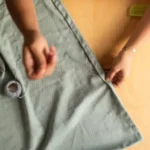Hand Sewing Supplies:

Before diving into the world of hand sewing, it’s essential to gather the necessary supplies. Here’s a quick list of what you’ll need:
- Sharp Scissors: A good pair of scissors is crucial for clean cuts and precision.
- Sewing Needle: Choose the appropriate needle for your project; common hand sewing needles, millinery needles, or upholstery needles, depending on the fabric.
- Thread: Select a thread color that matches your fabric, and consider using a stronger thread for thicker fabrics.
- Needle Threader: This tool can be especially helpful for those who find threading a needle challenging.
- Thimble: Protect your fingers from pricks with a thimble, particularly useful when working with thicker fabrics.
Thread Your Needle
How to Thread a Needle when Sewing by Hand
Threading a needle can be a bit tricky, but with practice, it becomes second nature. Follow these steps:
- Cut a piece of thread (about 20-25 inches).
- Use a needle threader if needed.
- Insert the thread through the eye of the needle.
- Pull the thread through, leaving a couple of inches for a knot.
Hand Sewing a Seam

How to Hand Sew a Seam with a Running Stitch
A running stitch is one of the basic hand stitches, ideal for simple seams. Here’s how to do it:
- Start with a knot at the end of your thread.
- Insert the needle through the fabric and pull it up.
- Insert the needle back down, creating even stitches.
How to Hand Sew a Seam with a Backstitch
For a stronger seam, use the backstitch:
- Begin with a small stitch forward.
- Insert the needle backward, passing through the previous stitch.
- Repeat for a secure and durable seam.
Sewing an Opening Closed
Hand Sewing an Opening with a Slip Stitch (Ladder Stitch)
A slip stitch is perfect for closing openings invisibly:
- Align the edges and thread your needle.
- Take small stitches, catching a bit of each side to create an invisible seam.
Hand Sewing a Hem

How to Hand Sew a Whip Stitch Hem
Whip stitching is excellent for finishing hems neatly:
- Fold the fabric edge and secure with pins.
- Take small stitches along the folded edge for a clean finish.
Hand Sewing a Blind Hem Stitch
The blind hem stitch conceals stitches for a nearly invisible finish:
- Fold the fabric to create a small hem.
- Take tiny stitches, catching only a few threads from the main fabric.
How to Hand Sew a Blanket Stitch Hem
The blanket stitch adds a decorative edge to hems:
- Space out even stitches along the hem edge.
- As you pull the thread taut, create diagonal stitches for a charming finish.
Practice, Practice, Practice!
To master hand sewing, consistent practice is key. Experiment with different stitches on scrap fabric before tackling larger projects.
Conclusion
Sewing by hand offers a connection to the rich tradition of craftsmanship while providing the flexibility to work on a diverse range of projects, from delicate fabrics to heavy materials. The importance of practice cannot be overstated. Consistent and intentional practice not only hones your skills but also builds confidence, transforming you into a capable hand sewer.
So, gather your supplies, thread your needle, and let your creativity flourish through the rhythmic dance of the needle and thread. Whether you’re working on DIY projects, exploring different stitches, or simply repairing a cherished item, hand sewing is a journey worth taking—one stitch at a time. Happy sewing!
FAQ – Hand Sewing Stitches
Choose a thread that matches your fabric for a seamless look. Thicker threads work well for heavier fabrics, while finer threads are ideal for delicate materials.
Threading a needle without a needle threader requires patience. Wetting the tip of the thread can make it easier to insert through the needle eye. Alternatively, you can flatten the thread’s end with your fingers before threading.
For delicate fabrics like silk or chiffon, opt for finer needles such as embroidery needles or beading needles. These needles help prevent damage to the delicate fibers.
Start your seam with a small knot or a backstitch for added strength. At the end of the seam, make a secure knot or backstitch again to prevent unraveling.
While regular scissors can be used, it’s advisable to use sharp fabric scissors for cleaner and more precise cuts. Using dull scissors may lead to frayed edges.
A thimble is worn on the finger to protect it from the needle’s point. It provides leverage when pushing the needle through tough fabrics, preventing finger strain.



GIPHY App Key not set. Please check settings
2 Comments